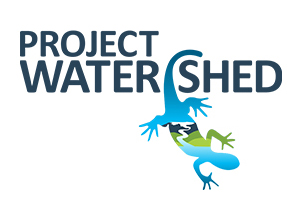Technician Tuesday Report – Solarization Experiment and Gary Oak Surveying – August, 30
At Glen Urquhart, Renée and Jay set up a solarization experiment. This is a restoration technique that will eliminate unwanted vegetation to prepare the area for planting Camas seeds and other native vegetation. They staked a large plastic sheet tight to the ground where the invasive plants were growing. The soil under the plastic cover heats up, killing the weeds and any weed seeds deep in the soil. Once free of invasives, this area will act as a temporary nursery; native species will be planted and once they are big and healthy and the season is right, they will be replanted elsewhere in the valley.
Renée also began preliminary work for a new citizen science program that may come out this fall called “Host a Garry Oak” where acorns that have been collected by Project Watershed from local Garry Oak trees will be given to members of the community to be potted and cared for over the winter and spring. Renée surveyed Courtenay for locations of Garry Oaks and noted which have acorns and which are not producing this year. It’s been a fun scavenger hunt! Renée also made pamphlets about Garry Oak ecosystems and the “Host a Garry Oak” project, which may be available for distribution in the weeks to come.
Did you Know…
Garry Oaks are one of many tree species that produce large amounts of seeds at a seemingly unpredictable rate every few years that is synchronized over large areas. This is known as “seed masting”.
The trigger for a mast year is not fully understood but one hypothesis is predator satiation. In this theory, masting helps plants evade seed predation by starving predators during years of minimal seed production and satiating predators in mast years.
Related Posts
Mallard Creek Restoration Update for 2024
Restoration work in Mallard Creek will continue this year, including invasive removal, restoring connectivity, and trial planting of a new riparian species. Volunteer events starting in September 2024.
Volunteer at Kus-kus-sum Chamber of Commerce Event
We are showing Kus-kus-sum off to businesses in the Valley through a Chamber Business to Business event. We are looking for a few volunteers to assist with this event.
Coastal Plant Monitoring
Get involved with our new vegetation community science monitoring program!
Spring Field Trips
Throughout May and June Project Watershed will be taking elementary school classes out on field trips to learn about estuary and coastal ecology and to assist with planting and plant maintenance.
Working Together to Identify Forage Fish Spawning Beaches
This year marks the 5th year of a partnership between Comox Valley Project Watershed Society and North Island College on a long-term study to examine intertidal spawning habitats of forage fish in the northern Salish Sea.
Glen Urquhart Update – Spring 2024
Latest news from Glen Urquhart restoration progress for spring 2024.



